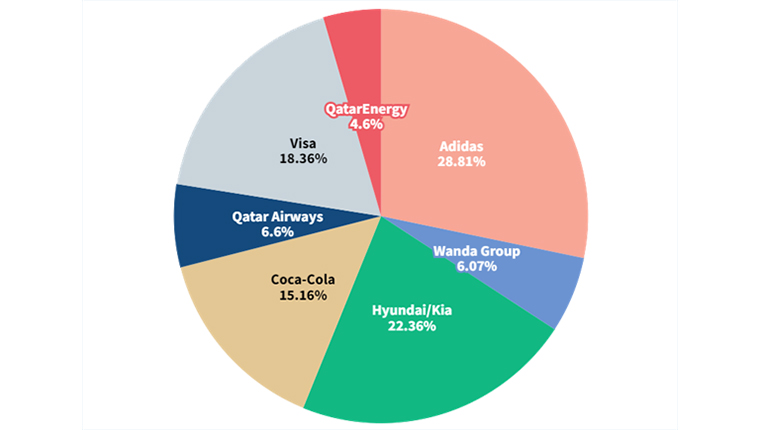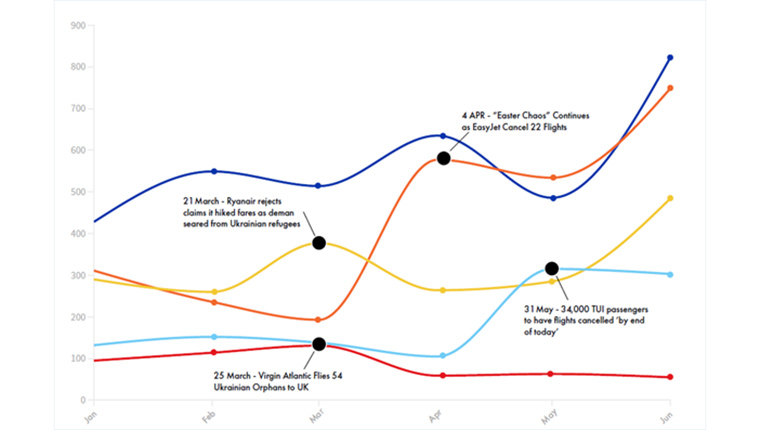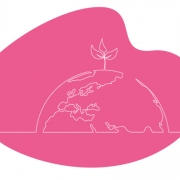How are national press and broadcast news using the Journalist Enquiry Service?
The headlines across national newspapers and news broadcasts have been dominated in recent months by the cost-of-living crisis, numerous strikes in different sectors, the Russia/Ukraine war and the fallout from Prince Harry’s book ‘Spare’. However, plenty of other stories have made their way into the UK news cycle, and many start with a request sent by a writer via the ResponseSource Journalist Enquiry Service.
What exactly have national press and broadcast journos been looking for recently? Below we take a deep dive into the main categories that our users have been interested in and the keywords that we are seeing most frequently. Read on to see how you can get your expert coverage or the best place to get that case study out.
Firstly, we will have a look into national newspapers as journalists from these titles use the service more frequently than broadcast – 26% of all requests in 2022 came from national press. Outlets like The Daily Express, PA Media and The Daily Telegraph also regularly feature in our top ten outlets sending requests from month to month.
We looked at all the requests sent from the start of November until today and the category with the most enquiries was Women’s Interest & Beauty, representing 11% of all national press requests. This proves particularly popular with the tabloid papers as The Sun, The Daily Express and The Daily Mail all feature in the top five outlets sending requests for this category.
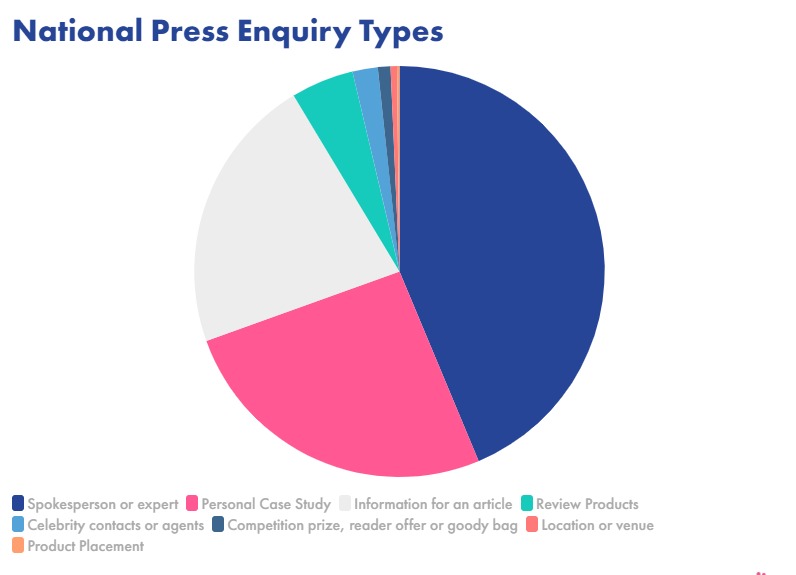
In terms of what they are looking for within this category, it tends to be for products to review or feature on their website. This varies from lipsticks and eyeliners to new beauty treatments and jewellery and fashion accessories. There are also requests around men’s beauty and grooming including requests for face creams and beard shavers. This presents a great opportunity to get client products featured in national newspapers or on their websites.
Often picked alongside the Women’s Interest & Beauty category is the Health category, which was the second most popular and made up 10% of the total requests from national newspapers. The Daily Express was again among the top senders with journalists from The i paper and Metro also sending numerous requests for health stories.
The trend here is more for spokespeople and experts and for case studies. A lot of requests are for doctors and GPs to give medical advice on certain conditions and there are frequent requests as well looking for case studies for people with certain conditions or illnesses. Both provide avenues to get clients and experts national press coverage.
The Health category also features several strongly performing keywords with ‘fitness’ appearing in 4% of all national press requests, ‘diet’ in 2% and ‘wellbeing’ in just over 1%. Again, this is often linked to enquiries for experts such as nutritionists, psychologists, mental health experts and sleep experts. This also links to the strong performance of both the Food & Drink and Leisure & Hobbies categories as they both received around 6% of the total national press requests.
Men’s Interest finished as the third most popular category. As we touched upon earlier, men’s grooming and beauty were part of these requests along with many around men’s health and also fashion too. This also links into the strong performance of ‘fitness’ as a keyword with requests for personal trainers and male gym instructors.
Fourth on the list for national press categories is Personal Finance which links into another key phrase that we have mentioned often in our monthly reports, which is the ‘cost of living’. This appeared in just over 3.5% of all national press requests with associated words like ‘energy’ on 3%, ‘bills’ on 2% and ‘mortgage’ on 1%.
This category attracted different national press outlets with both The Daily Telegraph and The Times featuring in the top ten. The type of enquiry did vary but a lot were looking for finance experts to give advice on ways to make savings during the cost-of-living crisis. There we are also enquiries for energy experts to provide analysis of the rising gas and electricity bills. Plus, mortgage experts to provide suggestions for what first-time buyers should do and those looking to renew their mortgage during increasing interest rates.
There has also been requests from the national press looking for case studies to find out how families are coping during the tough economic times and also to provide information on what businesses can do. This gives lots of scope to push out information and experts around personal finance.
The bigger news stories over the last few months have created a bit of traction on the Journalist Enquiry Service. ‘Strikes’ appeared as a keyword in 1% of all national press requests as papers like The Independent and Daily Mirror looked to cover the issue by getting case studies. ‘Royal’ was in around 3% with The Daily Express and The Guardian among others looking for royal experts to cover news around Prince Harry and Meghan and the Royal family in general. However, there have only been a handful of requests around the Russia/Ukraine war.
The focus for broadcast journalists using the service has been quite different with the most requests going to the Business & Finance category. 7% of the total requests from broadcast were for this category with 5 News and ITV News sending the majority.
These have tended to be for case studies and most often looking to speak with businesses that have been affected by the cost-of-living crisis. Just over 8% of the total requests in broadcast included the key phrase ‘cost of living’ and over 7% were for ‘energy’. This shows a much greater need from broadcast outlets to cover this issue and a great chance to get your clients featured on television, speaking about how their business has been impacted – especially in regard to rising energy bills.
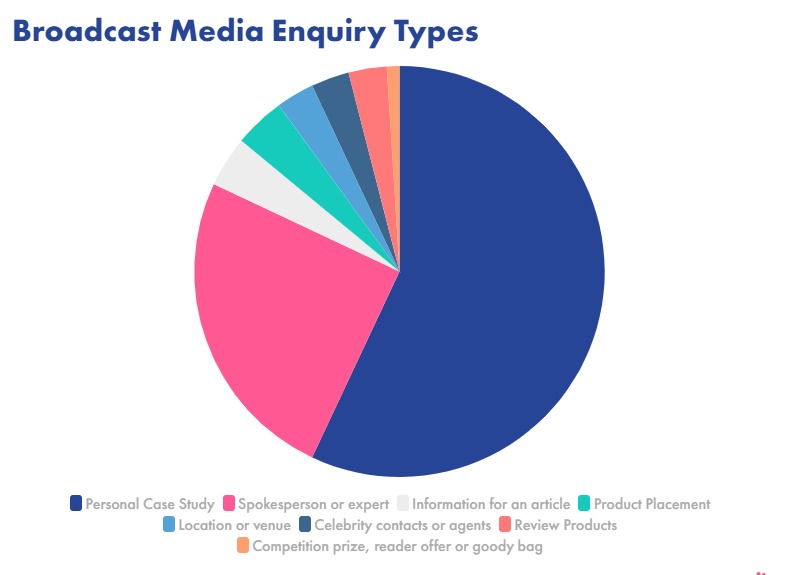
They have also dedicated more coverage to the strikes as well and ‘strikes’ as a keyword appears in 9% of the total requests from broadcast. This also links into the strong performance of the Public Sector, Third Sector & Legal category which was the fifth most popular for broadcast journalists. All three of the big broadcasters (BBC, Sky and ITV) appear in the top five outlets here.
These enquiries were again focused mainly on getting personal case studies and seeing how businesses and people were being affected. The majority of requests were for the rail strikes but broadcast contacts were also covering the nurses strike, the teachers, Royal Mail, ambulances and buses. With more strike action likely in the coming months then this should present more opportunities for television coverage.
The more consumer related categories of Food & Drink and Women’s Interest & Beauty both received 6% of the total broadcast requests, placing them second and third overall. The Food & Drink category was used quite frequently for Steph’s Packed Lunch, whereas the Women’s Interest & Beauty category had several enquiries from This Morning.
Again, several requests were for case studies, providing opportunities for people to feature on the show. However, we saw more enquiries looking for products. This varied from health and fitness gadgets to make up and fashion items to new chocolate and sweet brands. A good chance to get products featured on two well established daytime shows.
The Health category had around 6% of all the broadcast requests and finished as the fourth most selected. ITV and 5 News were again sending regular requests in this category along with GB News and BBC Radio 4.
Personal case studies were the main focus of requests looking to cover issues around social care and also around illnesses such as Strep-A. There were also several requests for experts as well, looking for medical experts to give advice and information.
Overall, while the media coverage may seem to focus on certain issues, there is room and opportunities for products, experts and case studies to get coverage on both national press and broadcast media for a variety of topics and matters. The news cycle is difficult to predict but the cost-of-living crisis looks set to rumble on, along with strike action. We are also starting to see more requests around ‘TikTok’ which as a keyword appeared in 1% of all national press requests and just over 1% of broadcast requests. Therefore, any experts or info around the media app could be vital to journalists in the coming months.
For more on how the ResponseSource Journalist Enquiry Service can help with getting your stories into the UK media, read our previous how-tos:
No PR budget? No problem – using the Journalist Enquiry Service to gain coverage as a small business
How to tackle vague requests from journalists
6 reasons to stop searching #JournoRequest and try the Journalist Enquiry Service













